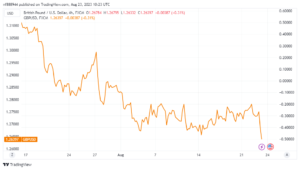GBPUSD began to decline and fell to a new weekly low below 1.2700.
After spending the Asian session in a narrow channel at approximately 1.2750. GBPUSD began to decline and fell to a new weekly low below 1.2700. Additional losses can occur soon if the pair is unable to retake 1.2700.
The private sector’s economic activity declined in August according to UK data.
After the UK data showed that the economy was losing speed. There was intense selling pressure on the pound. Manufacturing S&P Global/CIPS PMI fell to 42.5 (flash estimate) in August, while services PMI fell to 48.7 from 51.5 in July. Interest rate swaps, according to Reuters, indicate that following the poor PMI results, markets are pricing in fewer than 50% of the Bank of England’s terminal rate hitting 6%.
“The early PMI survey for August suggests that inflation should moderate further in the months ahead, but also indicates that the fight against inflation is carrying a heavy cost in terms of heightened recession risks,” said Chris Williamson, Chief Business Economist at S&P Global Market Intelligence, analyzing the details of the PMI surveys.
“While another hike in interest rates appears to be on the cards for September,” Williamson noted, “the August PMI data will add to speculation that rates may soon peak.”
In the afternoon, S&P Global PMI data from the United States will be scrutinized for new impetus. Although positive PMI statistics may bolster the USD, a bullish start on Wall Street may make it tough for the currency to maintain its momentum. At the time of publication, US stock index futures were up 0.4% to 0.75%.
GBPUSD Technical Outlook
GBPUSD has reverted to the descending channel, and the four-hour chart’s Relative Strength Index (RSI) indicator has dropped to 40. 1.2650 (the mid-point of the descending channel) is the first support level, followed by 1.2615 (the August 14 low) and 1.2600 (the psychological level, static level).

Buyers may show interest if GBPUSD rebounds over 1.2700 (upper limit of the falling channel) and begins to use that level as support. In that case, the pair may encounter stiff resistance in the 1.2740-1.2750 range. The Simple Moving Averages for 20-, 20-, and 100-periods are shown.








